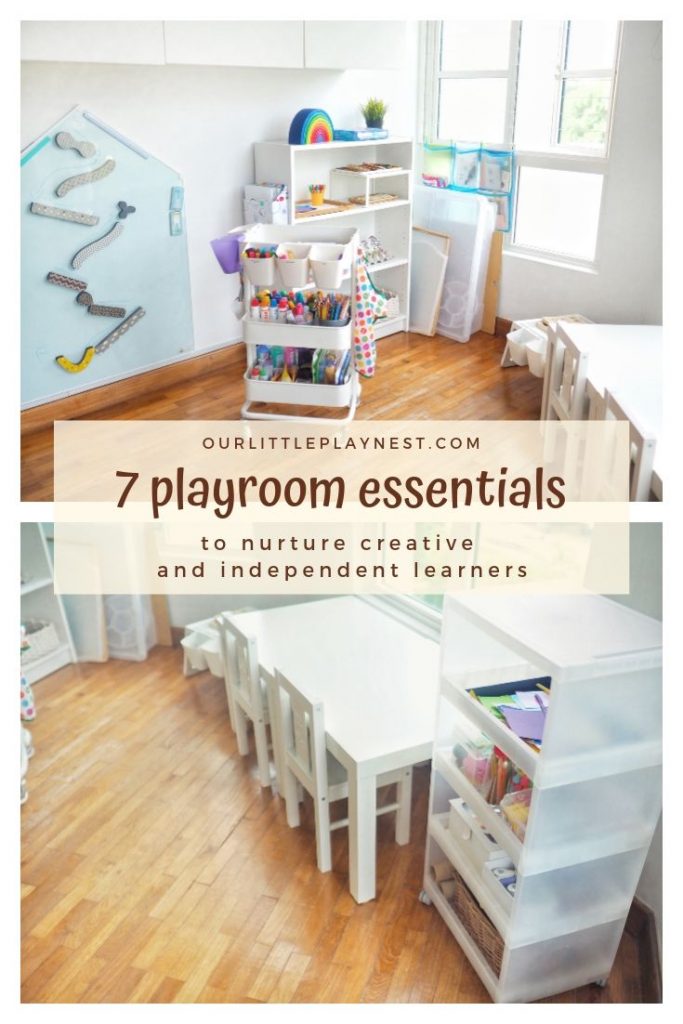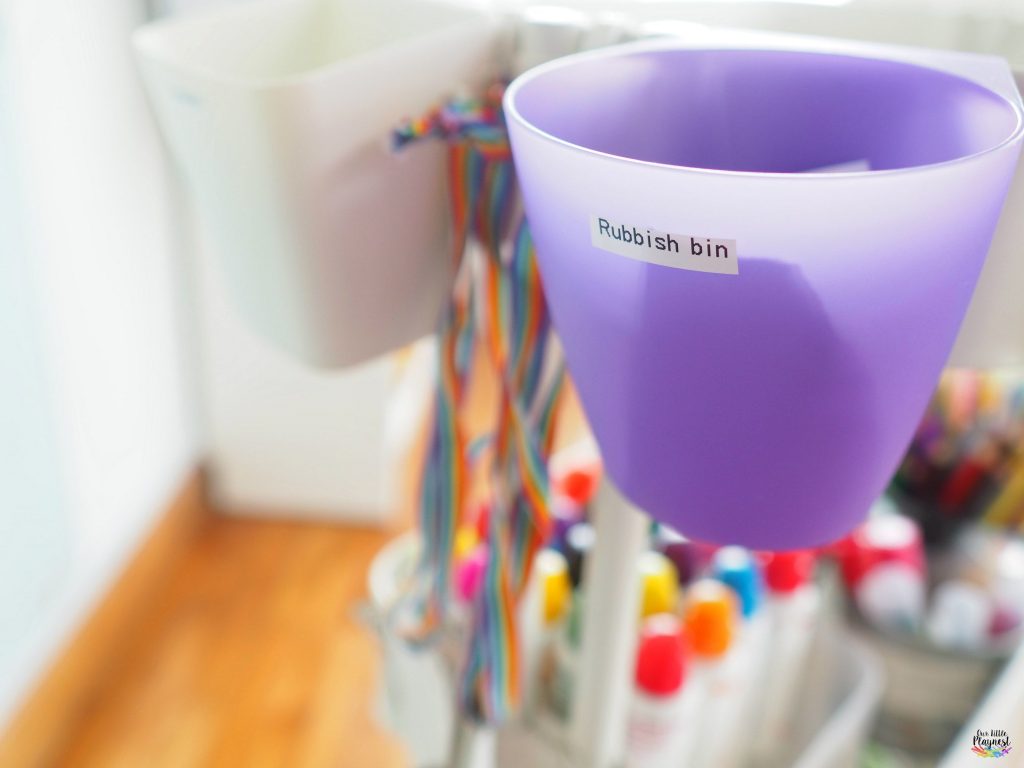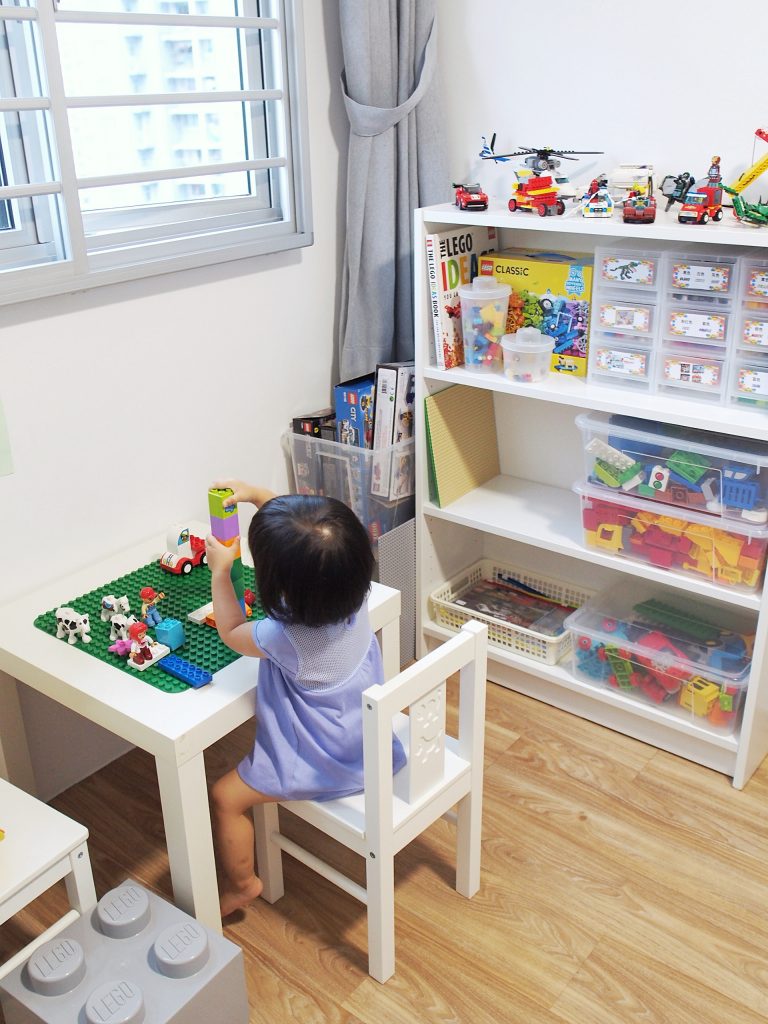Create the right environment for your children, and they will thrive. An organized space encourages children to play independently. In addition, having the right toys and resources help to nurture creativity and inculcate a sense of responsibility in children.
There are way too many ideas on the web, let me narrow them for you! I’ll share just the essentials of a playroom that help nurture creativity and encourage independence in your children. If you are looking for inexpensive and space-saving organization tips, read on!

1. A print-rich environment
Allow your children to interact with many forms of print like books, magazines, newspapers, newsletters, word displays, wall stories, poems.
Getting in touch with a print rich environment is one of the best ways to encourage your children to love reading, foster their language skills and develop their creative thinking.
Other than the book shelf in the children’s’ bedroom, I placed books in baskets and a mini shelf around the house. I also put up displays of the words or pictures that they are learning.

TIP: I used to put up many charts at one go, and I found that a bit too overwhelming for my children. I began to rotate them so the kids are attracted to “new” charts every 2-3 months.
Read about our book recommendations here.
2. Creative trolleys
I make supplies accessible to the children to encourage them to be independent. They can help themselves to the buffet of materials whenever they feel like creating. The supplies in your creative trolley will vary from others’ because every child is different.

Important! The resources you stock up must be safe for your children, eg. keep pom poms away if you have a mouthy baby! The supplies you put out must be comfortable enough for YOU when your children use them independently. This means that if you feel stressful leaving paints and glue around, then put them at a higher shelf. Teach them how to ask for permission and show them how to be responsible users.
I have two trolleys to house the supplies for my children.
-

Cutting Box -

Recycled Box
I have created a list of Essential art supplies that I used. Read to the end of the post to download the supplies list. You can bring it along as you go shopping!
TIP: Use gift boxes, iphone boxes or cereal boxes to store the art supplies. There is no need to spend extra money to purchase new storage containers.
Need inspiration for cutting activities? Click here!
3. Low shelves, baskets, boxes and trays to display toys
A low shelf encourages independent play as children can help themselves to their own toys without having to ask for assistance. Having similar toys in baskets, boxes or trays teaches children to categorise their toys, and it simplifies cleaning up.
-

Trays for activities -

Book case for Toy Rotation -

Pom Poms Sensory Box
I use the ikea Billy bookcase, bed trays and samla boxes from ikea, plastic boxes from Toyogo, baskets and small trays from Daiso or Taobao.
TIP: Help your children develop a habit of cleaning up and keeping their toys at a young age. It is important to train their sense of responsibility and for us adults to role model too (means we have to do our own cleaning up too, the kids are watching!)
4. Recycled papers
Having papers around encourage children to doodle within limits and foster their creativity skills. When my toddler girl began drawing on the walls and sofa, I know it is time for her to know the rules.
I set up this box of recycled papers and told the children that they can help themselves to the papers here. I wouldn’t say that my girl stopped drawing on furniture entirely, but with papers accessible, she has been conditioned to grab a piece when she wants to doodle.

TIP: Initially, I placed these recycled papers on a tray, but I noticed that the children have difficulty reaching for the papers below if the tray is covered with other things like their art work or books. So I upcycled a cereal box and turned it into a paper holder, placed it vertically along the shelf (with 3M tapes) and voila! No more piles of papers!
5. Open-ended toys
Most of the children’s toys are open-ended ones because I like how these toys develop creativity, decision making and problem solving skills. There is more than one way to play with the toys, so children hardly have to approach any adults for help since there is no right or wrong.
These open-ended toys are rarely rotated because my kids play with them all day, with all sorts of combination. Some days they build the tracks with animals, the next day the same animals are housed in playmag tiles.
TIP: I keep the toys in translucent boxes so the children can view the boxes at a glance and decide which boxes to bring out. I label the boxes to encourage the kids keep their own toys at the end of each day. I house these boxes in a separate room because of space constraints, but you can always place them in the play area.
6. Calming environment
A cluttered space creates anxiety, tension in relationships and overwhelms our children. It is important to provide a clean, cozy and calming play area that helps to nurture our children’s creativity and independence. How do you create a calming space?
Toy rotation
Children nowadays own many toys, some bought by us parents, some are gifted to them. Over the years, I noticed that displaying all the toys (even if they are organized in boxes) are too overwhelming for my children and I even heard my son comment “I don’t know what to play” I was astonished because the entire room was filled with toys!
I began to realise “less is more”

I started to declutter and came up with a toy rotation system. Suddenly, the children have plenty of “new toys”, just because they haven’t played with it for a while. My son never complains about not knowing what to play, because he gets to try the rotated toys every 2 weeks. I have since cut down on buying toys for the children.
I share a bit about how I rotated the toys here in this IG post. I will be coming up with a detailed toy rotation post. Join our VIP list here so you can receive exclusive news and get notified of new posts!
Encourage your children to clean up
Include rubbish bins, small dust pans etc to involve your children in cleaning up their play area. Provide them with these tools so that they can develop a sense of ownership of the play area that they spend so much time in.

⠀⠀⠀⠀⠀⠀
Calming colours in the room
Use furniture of neutral colours to create a restful environment and help soothe children. (I will avoid a red wall for the kids’ room!) Display their art pieces, add in some plants or dried flowers to brighten up the area.

7. Create play corners.
While I do have a small space specially dedicated for the kids to create and play, I also allow them to play in the living room, dining area etc because I believe that play can take place anywhere and everywhere! There is no need for dedicated play area.
-

Art Corner -

Lego Corner -

Puzzle Corner
I recommend setting up play corners at different parts of the house eg. lego corner, pretend play corner (eg. dress up area / food and kitchen play), reading corner, art station, puzzle table etc.
It is not necessary to restrict them playing at one location; my children like to build a “city” of tracks and blocks from my bedroom to the living room, or pretend play under the dining table.
Having play corners give children the options to decide where they want to be, and what they want to do. This helps develop their leadership, decision making skills as they work with the resources available at each designated area.

TIP: If you have space restrictions, I strongly encourage getting movable furniture like small tables/chairs and trolleys so the children can play at any available space in the house.
MOST IMPORTANTLY
Independent learners are not honed in a day or weeks. In fact, it can take years to encourage your children to gain the confidence to play on their own. My advice, not to rush them, but provide the hardware and software needed for children to play and learn.
Eventually, our children will pick up the confidence to play on their own. (Although deep in our hearts, we don’t really want the kids to grow up so quickly? :D)
Do you know of any other must-haves in a play area? Do share with us below.
Here are other mummies who shared their their toy rotation strategies and play guide:
- Nicole from Thekavanaughreport sharing her montessori way of toy rotation
- Raluca from Playfulnotes.com sharing her step-by-step guide to encourage independent learners.
- Playfullearning.net sharing the art of rotation
- Juliana from Stories of Play sharing her guide to play
As promised, here’s your Essential Art Supplies List, sent directly to your inbox! (Do check ‘spam’ if you do not receive it! Else contact me here!)







